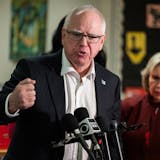Xcel Energy will partner with Form Energy to install a battery in Becker that would store electricity for considerably longer periods of time than current grid batteries.
Xcel also on Thursday reported a 19% increase in fourth quarter profits over a year earlier.
Xcel and Massachusetts-based Form Energy said the Minneapolis-based utility would deploy batteries in Becker and in Pueblo, Colo., the sites of Xcel coal plants that are slated to close.
The projects would be among the first for Form Energy and its promising battery technology.
Both Xcel batteries, which are subject to regulatory approval, are expected to come online as early as 2025. Xcel did not disclose costs.
Form's iron air battery would store electricity for 100 hours, compared with the four-hour standard of most lithium-ion grid batteries. The mineral at the heart of Form's technology is iron.
"As we build more renewable energy into our systems, our partnership with Form Energy opens the door to significantly improve how we deliver carbon-free energy," Xcel CEO Bob Frenzel said in a press statement.
Form is expected to roll out its first pilot project in 2024 for Great River Energy, a Maple Grove-based wholesale electricity cooperative. It will be located in Cambridge, Minn., and Great River will consider a larger Form battery depending on the pilot plant's performance.

![A black bear stopped after crossing Big Bay Road on Madeline Island, the largest of the Apostle Islands in Wisconsin, on Monday, May 31, 2021. ]](https://arc.stimg.co/startribunemedia/PWNYGIY3WTSWDBOGOYD775DPP4.jpg?&w=80&ar=1:1&fit=crop)

